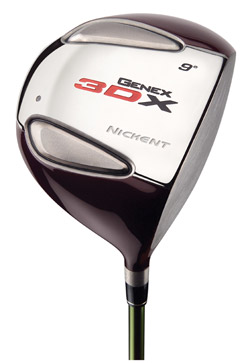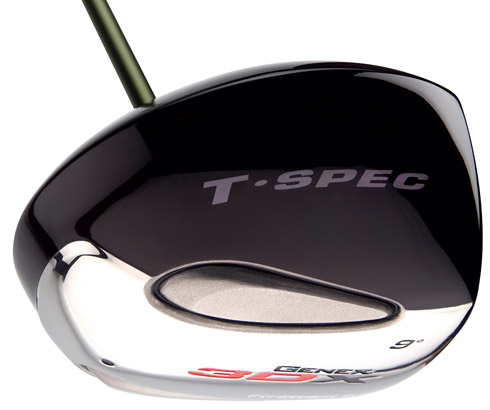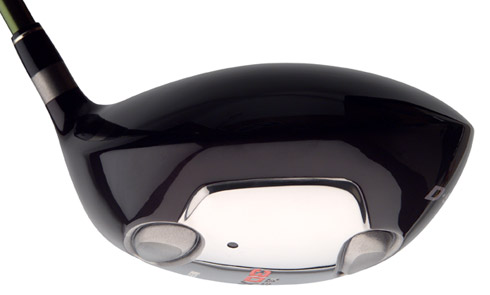 It doesn’t take a big name to make a big driver that is big on performance. Case in point: Nickent Golf’s new 3DX Driver. As far as the USGA and R&A are concerned, this is the largest conforming driver you’ll ever play. Is the performance in proportion to the size?
It doesn’t take a big name to make a big driver that is big on performance. Case in point: Nickent Golf’s new 3DX Driver. As far as the USGA and R&A are concerned, this is the largest conforming driver you’ll ever play. Is the performance in proportion to the size?
Nickent Golf was founded in 1996 and is a young company in every sense of the word. Most of its key personnel are thirtysomething or younger, and the brand was still flying under the radar as recently as last year. That’s when its 3DX Ironwood hybrid clubs started showing up in the bags of Nationwide Tour players. The usage numbers grew quickly, and Nickent overtook several well-established competitors as the 3DX became the #1 hybrid in play on that tour by year’s end. Tim Petrovic recently used one to win the Zurich Classic on the PGA Tour, and the company’s Pipe putter is also generating some buzz.
So Nickent finds itself on something of a roll as its new 3DX Driver hits the marketplace. As the well-worn marketing axiom states, “Go big or go home.” One look at the 3DX Driver and you’ll see that Nickent isn’t going home any time soon.
 Construction
Construction
The 3DX Driver isn’t just big. It’s as big as it can get, according to the performance limitations imposed by golf’s governing bodies.
Quick quiz:
Q: What’s the maximum allowable size for driver?
A: 460 cubic centimeters.
Q: What’s the maximum allowable coefficient of restitution (CoR) for a driver face?
A: 0.83
Q: What’s the maximum allowable hitting area for a driver?
A: 5 inches wide by 2.8 inches deep.
Q: What are the dimensions and COR of the Nickent 3DX Driver?
A: See previous answers.
Yes, the 3DX is a driver that has no room to grow. It is as large and as hot as it can be without being “illegal.” There are other 460cc drivers on the market, but the huge, deep face of the 3DX Driver induces double-takes. It’s hard to believe a face can be so large. If you’ve ever had the fear you might whiff on a drive, the 3DX is absolutely for you.
Size isn’t everything, and it can even be a hindrance. Super-large drivers can be prone to slicing (since the toe of the club tends to lag behind), and deep-face drivers can cause slower-swing speed players to have trouble getting shots airborne. Nickent uses its 3DX weighting system to alleviate both problems.
Nickent positions the 3DX as a driver that can compete with drivers that have interchangeable weights, like the TaylorMade R7. The 3DX doesn’t have interchangeable weights, but it does give you options. The driver is available in two models: D-Spec and T-Spec. The D-Spec (Draw-Spec) is weighted to help eliminate slicing by positioning weight toward the heel of the club, helping to square the clubface at impact. Nickent estimates that 90 percent of average players fight a slice, and the D-Spec is for them. Meanwhile, the T-Spec (Tour-Spec) version is set up with neutral weighting for players that like to have more versatility in shaping shots and don’t need help with a slice. Nickent calls this approach “Directional control with no screws attached.”
I tested the D-Spec version of the 3DX. I don’t usually have trouble with slicing, but I found the driver to be a straight shooter. That’s in contrast to some draw-biased drivers that are hook machines. With the 3DX, my drives were most often straight or slight draws. And when I needed to hit a cut, the 3DX was up to the task.
The weight shifting in the 3DX is accomplished through use of two weight ports along the sole of the club that run perpendicular to the clubface, like rails. A total of 20 grams of weight is shifted low and deep in the weight ports. The weight is distributed differently from the D-Spec to the T-Spec models, creating identical-looking drivers that have distinct centers of gravity and moments of inertia, and the lie angles are also tweaked to further influence ball flight.
The clubhead itself is made of SP-700, a titanium alloy cast under extremely high pressure for greater strength. The face is plasma welded, saving seven grams of weight over a traditional weld. This advanced production process is what allows Nickent to make the 3DX clubhead so large without becoming too heavy or too brittle. Making a driver that is this large that still feels and plays well is quite an engineering feat.
Aside from the clubhead, the 3DX Driver has some other high-tech components. The stock shaft is a version of the Aldila NV graphite shaft tweaked for top performance with the 3DX clubhead. The D-Spec models sport a 55-gram version of the shaft, while the T-Spec models bump up to a 65-gram weight class. (More on shaft performance below.) And the stock grip is a lightweight, soft Winn V-17 model with a ribbed texture that felt a bit like something that would be on bike handlebars. It was a bit odd at first, but it did the job and looked unique.
Esthetics
At first glance, the 3DX Driver appears to look similar to many other drivers on the market today. At address, the clubhead appears to be a dark charcoal color. But when the light catches it just so, the head shows a deep burgundy tint that is unique and bold. It is not unlike a metallic paint color you’d see on a sports car, and it gives the 3DX a very premium look. A small, tasteful Nickent logo marks the center of the clubface for alignment help.
The face is brushed metal with a scoreline pattern that accentuates the center of the face. After a couple rounds and a quick wipedown with a wet towel, the face was blemish-free and looked brand-new. The sole of the club has a mirror finish in the center of the club with the dark burgundy of the top carried over on the sides for a racing-stripe effect. Again, the esthetics here are crisp and upscale. The clubhead is matched by a big, zippered headcover with a cool translucent zipper pull. A very nice package. And if your golf clubs look good, you play good, right?
Sound-wise, the 3DX is solid. More of a solid “whack” than a loud metallic sound, which I like. The feel at impact was also very meaty. The 3DX reminded me, in terms of feel and sound, of the venerable old Titleist 975D, but with more of a springy feel. Not bad company at all.

Performance
So the 3DX Driver is big and beautiful. Is it all show and no go? Hardly. In fact, there’s plenty of go in this driver.
I tested the 9°D-Spec version. I usually play drivers that have at least 10 degrees of loft. But the 3DX gave me the nice high trajectory I’ve come to love from today’s high-launch, low-spin drivers. Personally, I loved the deep-face design. I was able to tee the ball up as high as I wanted, which is pretty high. The sweet spot seemed to be just above the center of the considerable clubface, so I advise you to tee the 3DX high before you let it fly.
The 3DX weighting system certainly worked for me, as off-center hits were barely penalized. I hit one drive way out on the toe and even felt the clubhead twisting from the poor impact. Yet the ball started down the right side of the fairway and gently draw back toward the center. It rolled out to approximately 260 yards. That’s short of my 275-yard average off the tee, but much better than I expected from such a bad swing. I expected a horrible push-slice that might have gone 200 yards and been deep in the right rough. Instead, I was in the short grass and only hitting one more club into the green than I might have on after a better swing on the tee.
This forgiveness gave me the confidence to really go after the ball with some aggressive swings, and the 3DX was up to the challenge. The Aldila NV shaft plays very stable for such a lightweight model and gave me good results even when I got a bit quick with my tempo. But the thing I liked most was that the shaft/head combo responded well to a variety of swings. I could put a smooth pass on the ball, or I could swing from my heels, or anywhere in between. The results were almost always outstanding. On my smoother swings, ball flight tended toward a mid-high draw with nice run. On my hardest swings, I got mostly straight balls with a penetrating trajectory and lots of roll. I took a big swing at a drive on a 540-yard par-5 that I’ve only ever reached in two with a fairway wood for my second shot. I was pin-high with a 6-iron second shot after a downwind 340-yard bullet with the 3DX.
My playing partners also found the 3DX very complimentary to their swings. One has a smoother, slower swing and tends to lose the ball right. His handful of swings with the 3DX produced a series of tight draws that were his best drives of the day. Another tester with a high swing speed hit a couple tape-measure blasts, including a ridiculous 310-yard drive uphill and into the wind.

Conclusion
The Nickent 3DX Driver worked remarkably well for me and for a group of players with widely varied swings and ability. I would have guessed from its deep-face design that this would be a good driver for stronger players. But the D-Spec version brought out the A-Game in me and my playing partners. This driver is fun to hit, and it is forgiving and long. And its sheer size was a good conversation starter, too. It put a big smile on my face.
Specs
The Nickent 3DX Driver is available in D-Spec and T-Spec models with a street price around $250.
The D-Spec model is available in 9, 10, 11 and 12 degrees of loft with 55-gram Aldila NV shafts in S, R, R-Light and L flexes. All lofts are available in right- and left-handed except for the 12-degree, which is righties only.
The T-Spec model is only for righties. It is available with 7, 8, 9 or 10 degrees of loft with a 65-gram Aldila NV shaft in X, S or R flex. For more info, see nickentgolf.com.

The NV is a great choice for their standard shaft.
I have the Nickent 3DX 9 deg. T. It is a very consistent driver which nearly always finds the fairway and is considerably longer than all other drivers I have tried. Golf cronies often asked if I ever got sick of just being in the fairway all day. The answer is “nope.”
My first golf season averaged somewhere real close to 27 holes per week. I play with a group of (82-95 scoring) guys that are pretty fair teachers and have helped me go from 120+ to the 90s in just 3 months with no formal lessons. I mention this because when you play this much as a beginner you go through lots of changes really fast.
I learned on the course not a driving range so fixing a bad swing with a particular club as fast as possible became as much a part of golf for me as filling out the scorecard. I picked up the 10.5 3DX and went right to the course with one of my golf buddies. No range, just a few practice swings and a box of balls.
I have had days where I was crushing 320s and even a few 340+ but not since I started playing harder courses and had to really start dialing in accuracy. In the last few weeks I have been lucky to hit 260 with all of the stuff I have done to work on accuracy.
As we got to the first tee I noticed my iron stroking green assassin golf buddy had left his driver in his bag. There he was with a big smile and his hand out. How could I refuse.
3 practice swings later he crushed one about 285 yards dead straight down the left side of the fairway. I may have mentioned that this guy is an artist with his irons but 285 yards with a driver is something that just doesn’t happen for him. More importantly, its that “straight” part that is even more rare. Its kind of a running joke about his driver. Its always a low slice with lots of roll, which explains why his first shot with it was along the left side. ( I think he plays an FT3)
I got all giddy and duffed the first 2 shots (rookie!) but slowed down my swing and shot right over him another 20-30 yards flying the fairway entirely because it dogs right. We normally only allow a single mully on 1 or 10 but we each put three down the fairway with increasing distance and accuracy. My buddy was a chatterbox talking about the holes he couldn’t wait to try this club out on as we shagged our shots, played our “firsts”, and putted in.
I noticed right away that the club likes the ball a bit more to center than the other drivers I have tried and you really feel a bad swing so corrections are much easier. The sound tells you a lot about your ball striking too. It goes from a ping more to a pong the closer you get to the center of the gigantic sweet spot.
Hole 17( I think) on this course (River Oaks, Utah) has a blue tee that looks down about 150 feet to a fairway that extends to the left at about a 70 degree angle and goes for 400+. Its fun but dangerous to launch a ball off to the left and try to bomb at the green. Lots of big trees, shrubs, poison oak, and I think a small creek buried along the left edge of the fairway. To hit the green, it would have to fly an obscene 400 or so yards but what a place flew up on the new driver. We both grabbed three balls and started the “after you” routine.
After two balls a piece the marshall came rolling up the hill…. and stopped.
DAMN!
He waited for me to stroke another and then walked up and held out his hand. I thought we would get some grief for hitting a few but he wanted to try out my club. Nice.
We watched this 65+ year old guy wave two couples by as he got his fill of banging “junkers” off the hill and chatting about what he had read in magazines and heard from players about the square drivers. He said that he had heard the sound and just had to see what we were using. By his 2nd ball he was adjusting further down to the left because he was flying the fairway. We got to our “firsts” and were picking up our junkers as close as 40 yards from the green. Also nice.
We finished the course with new course records, balls to spare, and some observations.
This club will hit as far as any driver we have tried.
A bad strike will likely still have you on the short grass unless you fly the fairway.
Players that under-hit their drivers because of a clunky swing will enjoy watching the ball sail down the fairway again and will start playing more aggressively.
Its easier to feel what was wrong during a bad swing. It “wants” to swing correctly. When something is off you can really feel it.
The sound of the strike is different but quite informative. Not a smack. More of a ping around the outside and a very pleasant BONG! when you get the center
You can still play a fade or a draw. You have to mean to do it though. The square head gives you a better visual of your open/close angles so it may actually be more predictable than with conventional drivers.
The club doesnt seem to loft as much as I had heard about whe reading about other square drivers. The club this one replaces had me wanting to look at a 9 degree driver but as this is my first year I went with a conventional 10.5. I no longer see the need for the 9.
Golf “purists” should start using wooden clubs or shut up about these square drivers “ruining golf”. Bitter people who didn’t have access to these when they were learning will talk their line but the people I ran into at the golf course were very curious and wanted to try it. Even the 65 year old marshal.
I would strongly recommend this driver to newer or older players. I see no reason why the square head would be a limitation to a scratch golfer either. If anything it will help make more scratch golfers. I cant believe this thing is only $200. Iv’e checked around, you can spend twice as much and not get a better or even equal square driver.
What is the price of a Knickent, R-Flex, 3DX Driver Square, 10.5 please